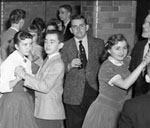1744 The first written record of ice cream in America (and the first use of the exact phrase "ice cream" rather than "iced cream" is made when a journal entry by William Black of Virginia notes that Maryland Colonial Governor Thomas Bladen notes servedice cream ("After which came a Dessert no less Curious; Among the Rarities of which it was Compos'd, was some fine Ice Cream which, with the Strawberries and Milk, eat most Deliciously…") to him and other dinner guests at the Governor's home in Annapolis:
not contested.
1774 Immigrant from London Philip Lenzi, a caterer, opens the nation's first ice cream parlor, on Dock Street in New York City. On May 12, 1777, Lenzi places the first advertisement for ice cream in America in The New York Gazette and Weekly Mercury, noting that he would make it available "almost every day.":
not contested.
1780s George and Martha Washington often serve ice cream to their guests. In one year alone, President Washington spends over $200 on ice cream, a huge amount at the time:
not contested.
1784 Thomas Jefferson records a French recipe for vanilla ice cream (custard based) in his recipe book. In 1802 at a White House state dinner, he serves small balls of vanilla ice cream encased in warm pastry:
not contested.
1806 Frederic Tudor begins cutting and shipping ice from Fresh Pond in Cambridge, Massachusetts, to states south and around the world:
not contested.
1813 James and Dolley Madison serve strawberry ice cream at Madison's second inaugural ball. Mrs. Jeremiah ("Aunt Sallie") Shadd, a freed black slave, who has a catering business in Wilmington, Delaware, makes the ice cream from her own recipe. Also working at the White House as a chef is African-American cook and entrepreneur Augustus Jackson, who, after he leaves the White House and moves to Philadelphia, creates many new ice cream recipes and a sophisticated system of distributing it to retail merchants in large tin cans:
not contested.
1832 Massachusetts brass founder John Matthews invents the soda fountain:
contested. Some sources credit Pennsylvania physician Samuel Fahnstock with inventing it in 1819. And some credit Jacob Ebert of Cadiz, Ohio and George Dulty of Wheeling, Virginia with inventing it in 1833, and taking out a patent on it.
1843 Philadelphia housewife Nancy M. Johnson invents the hand-crank ice cream freezer, and receives a patent for it, the rights to which she sells for $200 to wholesaler William G. Young:
not contested.
1851 Quaker Jacob Fussell, using icehouses and a large version of Johnson's ice cream freezing machine, begins to produce ice cream from his Baltimore, Maryland factory (and then in Washington, DC, Boston, and New York), and selling it on the street from carts, helping to turn ice cream into a cheap, regular treat:
not contested.
1867 J. B. Sutherland of Detroit, Michigan patents the refrigerated railroad car:
not contested.
1874 The ice cream soda is created by soda concessionaire Robert M. Green for the semicentennial celebration of the Franklin Institute in Philadelphia. He had been making soda drinks of sweet cream, syrup, ice, and carbonated water, a drink already well-known and called, fancifully, "ice cream soda." When he runs out of cream, he substitutes ice cream (Philadelphia-style vanilla ice cream, which means it was not custard based):
contested. Some sources say the ice cream soda was invented by two newsboys, John Robertson and Francis Tietz, at Kline's Confectionary Store in New York City in 1872, when they asked Mr. Kline to put a scoop of vanilla ice cream and a slice of pineapple into a glass of soda water.
1878 William Clewell, a confectioner in Reading, Pennsylvania, receives the first patent for an ice cream scoop. It is shaped like a candle snuffer:
not contested.
1881 The ice cream sundae is created, in Two Rivers, Wisconsin, by Ed C. Berners, who operates an ice cream shop at 1404 Fifteenth Street. A teen-aged customer, George Hallauer, asks Mr. Berner to put some chocolate sauce on his ice cream. Prior to this, chocolate sauce had been used only in ice cream sodas. Berners complies and charges Hallauer—and other customers afterwards—5 cents. He serves it only on Sunday:
contested. Some sources say the ice cream sundae was invented on Sunday afternoon, April 3, 1892, by Chester C. Platt, proprietor of the Platt & Colt Pharmacy in Ithaca, New York, when he improvised a bowl of vanilla ice cream, topped with cherry syrup and candied cherry, calling it a "Cherry Sunday," in honor of the day in which it is invented. Other sources say the phrase "ice cream sundae" was created in Evanston, Illinois, sometime in the late 1800s, when, in an effort to circumvent the religious ban against frivolously "sucking soda" on Sundays, Garwoods' Drugstore offered its customers what was essentially a concoction of everything in an ice cream soda, without the soda.
1894 Edson Clemant Baugham patents a spring-handle, one-handed ice cream scoop, which is manufactured by the Kingery Company of Cincinnati:
not contested.
1897 African-American inventor Alfred L. Cralle, while working in Pittsburgh, Pennsylvania, patents the lever-operated, half-globed-shaped, hand ice cream scooper:
not contested.
1902 Mechanical refrigeration takes over from ice and salts in the ice cream industry:
not contested.
1904 The ice cream cone is introduced, at the St. Louis World's Fair, Louisiana Purchase Exposition. An ice cream vendor named Arnold Fornachou runs out of dishes and a Syrian vendor named Abe Doumar (or a Lebanese vendor named Ernest A. Hamwi) seizes the moment to roll a "zalabia"—a sugar waffle—into a cone and comes to his rescue:
contested. Some sources say the ice cream cone was invented by Italian immigrant Italo Marciony of New York,  a pushcart ice cream vendor in New York, in 1896, who also, perhaps, invented the ice cream sandwich by putting a slice of ice cream between waffle squares cut from a sheet. Other sources say the ice cream cone has its origins in the mists of history, but was first described in Mrs. Marshall's Cookery Book, whose author, Agnes Marshall, published it in London in 1888. Still others discern a woman licking an ice cream cone in an 1807 picturing fashionable customers eating at the Frascati café in Paris, although this is uncertain because cone-shaped ice cream bowls were not unknown at the time.
a pushcart ice cream vendor in New York, in 1896, who also, perhaps, invented the ice cream sandwich by putting a slice of ice cream between waffle squares cut from a sheet. Other sources say the ice cream cone has its origins in the mists of history, but was first described in Mrs. Marshall's Cookery Book, whose author, Agnes Marshall, published it in London in 1888. Still others discern a woman licking an ice cream cone in an 1807 picturing fashionable customers eating at the Frascati café in Paris, although this is uncertain because cone-shaped ice cream bowls were not unknown at the time.
1904 Soda jerk (and soon-to-be graduate of University of Pittsburgh's School of Pharmacy) David E. Strickler invents the banana split (and the elongated dish to serve it in) while working in a drug store in Latrobe, Pennsylvania:
contested. Some sources credit Ernest Hazard, owner of Hazard's Restaurant in Wilmington, Ohio, with inventing the banana split in 1907, and his cousin, Clifton Hazard, with inventing the name "banana split."
1905 Eleven-year-old Frank Epperson leaves his fruit-flavored drink (powdered flavor plus water) outside in cold weather, with a stirring stick in it, and "invents" the "Epsicle ice pop," which he patents eighteen years later, in 1924. His children rename it the "Popsicle.":
not contested.
1906 In C. C. (Clarence Clifton) Brown's Ice Cream Parlour at 7007 Hollywood Boulevard in Los Angeles, California, the first hot fudge sundae is served:
not contested.
1910 President William Howard Taft begins keeping a Holstein cow named "Pauline Wayne" on the White House lawn, replacing one named "Mooley Wooly," who had provided milk (and from it, ice cream) for the First Family for a year and a half:
not contested.

1911 General Electric offers an electric refrigerator for home use:
not contested.
1919 Prohibition becomes law, causing some beer manufacturers to become ice cream manufacturers and some saloons to become ice cream parlors:
not contested.
1919 Onawa, Iowa inventor and high school teacher Christian Nelson, who moonlights as a soda jerk, invents the first chocolate-covered ice cream bar He calls it the "Temptation I-Scream Bar," and writes the advertising jingle, "I scream, you scream, we all scream for the I-Scream Bar." After going into partnership with confectioner Russell Stover, Nelson changes its name and patents it as the "Eskimo Pie.":
not contested.
1920 Youngstown, Ohio candy maker Harry Burt invents the first ice cream on a stick, the Good Humor Bar:
not contested.
1921 The Commissioner of Ellis Island provides that a scoop of vanilla ice cream be included in a "Welcome to America" meal for immigrants arriving through the facility:
not contested.
1922 Chicago Walgreens employee Ivar "Pop" Coulson takes a malted milk drink (milk, chocolate syrup, and malt), adds two scoops of vanilla ice cream, mixes it up, and creates the milk shake:
not contested.
1923 H. P. Hood of Boston introduces the paper cup filled at the factory with ice cream at the National Ice Cream Convention in Cleveland. He calls it the "Hoodsie," but it is renamed the "Dixie Cup" in 1924:
not contested.
1923 A & P supermarkets introduce ice cream cabinets in their 1,200 stores nationwide:
not contested.
1926 The Hershey's Company expands its product offerings to include Hershey's Syrup:
not contested.
1931 Ernest Wiegand, horticulturalist at Oregon Agricultural College (now Oregon State University) in Corvallis, develops the modern method of firming and preserving maraschino cherries:
not contested.
1940 J. F. "Grandpa" and H. A. "Alex" McCullough, proprietors of the Homemade Ice Cream Company in Green River, Illinois, begin to market "soft serve" ice cream under the name of "Dairy Queen.":
not contested.
1984 President Ronald Reagan designates July as National Ice Cream Month and the third Sunday of the month as National Ice Cream Day:
not contested.
 3. The first rapid transit railway in the U.S. was the elevated train built in New York City starting in 1868. New York's subway opened in 1904. This allowed easy access to downtown locations for potential customers.
3. The first rapid transit railway in the U.S. was the elevated train built in New York City starting in 1868. New York's subway opened in 1904. This allowed easy access to downtown locations for potential customers. From about the mid-19th century to the mid-20th century, the urban department store embodied America's highest ideal of retail shopping. It offered a variety of durable goods at various price levels in a single store.
From about the mid-19th century to the mid-20th century, the urban department store embodied America's highest ideal of retail shopping. It offered a variety of durable goods at various price levels in a single store.




 Yes. The recommended practice was to dive into the water headfirst, despite the already-mentioned advice to avoid shocking or chilling the body. The objective was to insure that one's body temperature remain uniform, which it would not if the head were not immersed at the same moment as the rest of the body. This was done in order to prevent "the rushing of the blood to the head," the consequences of which ranged from "unpleasant sensations" to death. Persons who could not swim (and therefore would not be diving headfirst into the sea) were advised to at least wet their heads and chests before immersing their bodies, or to "crouch down and let themselves be covered by the first wave, as they would by an energetic douche," as one authority put it.
Yes. The recommended practice was to dive into the water headfirst, despite the already-mentioned advice to avoid shocking or chilling the body. The objective was to insure that one's body temperature remain uniform, which it would not if the head were not immersed at the same moment as the rest of the body. This was done in order to prevent "the rushing of the blood to the head," the consequences of which ranged from "unpleasant sensations" to death. Persons who could not swim (and therefore would not be diving headfirst into the sea) were advised to at least wet their heads and chests before immersing their bodies, or to "crouch down and let themselves be covered by the first wave, as they would by an energetic douche," as one authority put it. Yes. However, the authorities didn't advise this simply because of the danger of drowning if one were tired or exhausted. Rather, they advised it also because they believed it to be harmful if one "disturbed" the bodily functions, like respiration, circulation, and digestion, by throwing them out of their usual courses: "Persons coming to the seaside," wrote one such authority, "should wait about thirty-six hours before taking any baths, in order to undergo a process of acculturation as it were so as not to upset their conditions of circulation by their change of residence and by the baths at the same time." How all this was supposed to work was only vaguely articulated, but that did not dampen the enthusiasm of some authorities for invoking the rule: "As bathing is not without its dangers," wrote one of them, "we would warn all boys not to begin the practice too early in the season, or to repeat it too often daily. Many have found an early grave by overindulgence, while others have endured long years of suffering from the obscure effects of excessive bathing."
Yes. However, the authorities didn't advise this simply because of the danger of drowning if one were tired or exhausted. Rather, they advised it also because they believed it to be harmful if one "disturbed" the bodily functions, like respiration, circulation, and digestion, by throwing them out of their usual courses: "Persons coming to the seaside," wrote one such authority, "should wait about thirty-six hours before taking any baths, in order to undergo a process of acculturation as it were so as not to upset their conditions of circulation by their change of residence and by the baths at the same time." How all this was supposed to work was only vaguely articulated, but that did not dampen the enthusiasm of some authorities for invoking the rule: "As bathing is not without its dangers," wrote one of them, "we would warn all boys not to begin the practice too early in the season, or to repeat it too often daily. Many have found an early grave by overindulgence, while others have endured long years of suffering from the obscure effects of excessive bathing."  Yes. This was regarded as undignified and immodest. One was expected to promenade and socialize on or adjacent to the beach (as opposed to being in the water) in one's ordinary clothing, not in one's bathing suit, especially in bathing suits that did not completely cover one's arms and lower legs. Fashion authorities recommended that ladies' bathing suits be made of material, like wool, that would not cling to them. Suits of muslin, for example, would display the intimate details of their bodily forms. Again, Americans were notoriously more lax about these rules than were Europeans. By 1890, newspaper humorists often joked about how scanty—by their standards—ladies' bathing suits had become. By then women's bathing suit fashions were being driven by their desire for uninhibited movement in the water, as well as by their desire to display their bodies to the gaze of admirers.
Yes. This was regarded as undignified and immodest. One was expected to promenade and socialize on or adjacent to the beach (as opposed to being in the water) in one's ordinary clothing, not in one's bathing suit, especially in bathing suits that did not completely cover one's arms and lower legs. Fashion authorities recommended that ladies' bathing suits be made of material, like wool, that would not cling to them. Suits of muslin, for example, would display the intimate details of their bodily forms. Again, Americans were notoriously more lax about these rules than were Europeans. By 1890, newspaper humorists often joked about how scanty—by their standards—ladies' bathing suits had become. By then women's bathing suit fashions were being driven by their desire for uninhibited movement in the water, as well as by their desire to display their bodies to the gaze of admirers. 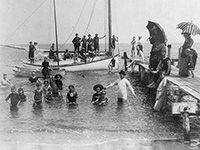


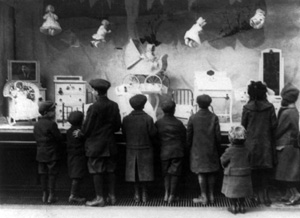
 a pushcart ice cream vendor in New York, in 1896, who also, perhaps, invented the ice cream sandwich by putting a slice of ice cream between waffle squares cut from a sheet. Other sources say the ice cream cone has its origins in the mists of history, but was first described in Mrs. Marshall's Cookery Book, whose author, Agnes Marshall, published it in London in 1888. Still others discern a woman licking an ice cream cone in an 1807 picturing fashionable customers eating at the Frascati café in Paris, although this is uncertain because cone-shaped ice cream bowls were not unknown at the time.
a pushcart ice cream vendor in New York, in 1896, who also, perhaps, invented the ice cream sandwich by putting a slice of ice cream between waffle squares cut from a sheet. Other sources say the ice cream cone has its origins in the mists of history, but was first described in Mrs. Marshall's Cookery Book, whose author, Agnes Marshall, published it in London in 1888. Still others discern a woman licking an ice cream cone in an 1807 picturing fashionable customers eating at the Frascati café in Paris, although this is uncertain because cone-shaped ice cream bowls were not unknown at the time.
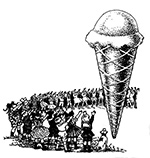

 1. a. Mass Plays, such as the "flying wedge" pictured here (invented in 1892 by a Harvard fan), were tremendously brutal and were soon outlawed. The rules were changed in 1894 so that no more than 2 players could go in motion before the start of the play. Also, the ball carrier's teammates were forbidden to push or pull him.
1. a. Mass Plays, such as the "flying wedge" pictured here (invented in 1892 by a Harvard fan), were tremendously brutal and were soon outlawed. The rules were changed in 1894 so that no more than 2 players could go in motion before the start of the play. Also, the ball carrier's teammates were forbidden to push or pull him.  2. b. For a long time, goals scored more points than touchdowns. Touchdowns were more valuable as a means of getting a favorable placement for an unimpeded try at kicking a field goal. The defense would play in order to prevent a goal rather than defending against a touchdown, making the "dribble" a possible offensive strategy until it was made illegal in 1887. Note that the player holding the ball for the kicker (lying on the ground) in the illustration here had to keep the ball off the ground as the kicker prepared himself because as soon as the ball touched the ground, it was in play.
2. b. For a long time, goals scored more points than touchdowns. Touchdowns were more valuable as a means of getting a favorable placement for an unimpeded try at kicking a field goal. The defense would play in order to prevent a goal rather than defending against a touchdown, making the "dribble" a possible offensive strategy until it was made illegal in 1887. Note that the player holding the ball for the kicker (lying on the ground) in the illustration here had to keep the ball off the ground as the kicker prepared himself because as soon as the ball touched the ground, it was in play.  3. b. This method of putting the ball in play (known as a "fair," as opposed to the play known as a "fair catch," described in the other possible answer), proved too unruly and prone to "slugging" as the players massed together near the sideline. It was eliminated by requiring the referee to bring the ball out from the sideline and place it in the middle of the field.
3. b. This method of putting the ball in play (known as a "fair," as opposed to the play known as a "fair catch," described in the other possible answer), proved too unruly and prone to "slugging" as the players massed together near the sideline. It was eliminated by requiring the referee to bring the ball out from the sideline and place it in the middle of the field. 4. True. When tackling below the waist down to the knees was allowed in 1888, the defense was strengthened and the offense therefore needed to be bolstered by the rules to keep the game balanced. To do this, the teammates of the ball carrier were allowed to "interfere" with (that is, move and block) the opposing team with their bodies (but not their hands and arms—note the illegal use of hands by the blockers in the picture) even after the ball had been snapped. Because these offensive players were in front of the ball after it had been snapped, any movement by them had previously been disallowed as "offsides play." The rule meant that the ball carrier could now run behind his teammates (who would block for him), and not (as in rugby) in front of them, ready to pass the ball back when he was about to be tackled.
4. True. When tackling below the waist down to the knees was allowed in 1888, the defense was strengthened and the offense therefore needed to be bolstered by the rules to keep the game balanced. To do this, the teammates of the ball carrier were allowed to "interfere" with (that is, move and block) the opposing team with their bodies (but not their hands and arms—note the illegal use of hands by the blockers in the picture) even after the ball had been snapped. Because these offensive players were in front of the ball after it had been snapped, any movement by them had previously been disallowed as "offsides play." The rule meant that the ball carrier could now run behind his teammates (who would block for him), and not (as in rugby) in front of them, ready to pass the ball back when he was about to be tackled. 5. True. The forward pass was not legal until 1906. Until then, a "pass" always meant the ball carrier's passing backwards. The extensive 1906 rule changes aimed to reduce violence and injury on the field, which had become pronounced, especially in the clash at the line of scrimmage. The changes were meant to "open up" the play. Most notable among the changes was the increase in the number of yards the offense had to advance in a series of downs from 5 to 10, and the allowing of forward passes, which was meant to spread out the players more. Oddly, many football pundits, when the rule was changed and for some time afterwards, did not think the forward pass would be popular. This was partly because, at first, the new rule stipulated that if the pass was incomplete, the ball had to be turned over to the opposing side, and partly because no one had figured out how to throw an effective, spiraled forward pass. The shape of the ball then evolved to make passes easier, becoming a little smaller and more pointed.
5. True. The forward pass was not legal until 1906. Until then, a "pass" always meant the ball carrier's passing backwards. The extensive 1906 rule changes aimed to reduce violence and injury on the field, which had become pronounced, especially in the clash at the line of scrimmage. The changes were meant to "open up" the play. Most notable among the changes was the increase in the number of yards the offense had to advance in a series of downs from 5 to 10, and the allowing of forward passes, which was meant to spread out the players more. Oddly, many football pundits, when the rule was changed and for some time afterwards, did not think the forward pass would be popular. This was partly because, at first, the new rule stipulated that if the pass was incomplete, the ball had to be turned over to the opposing side, and partly because no one had figured out how to throw an effective, spiraled forward pass. The shape of the ball then evolved to make passes easier, becoming a little smaller and more pointed. 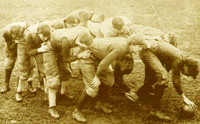

 False. Moses Fleetwood Walker, an Oberlin College star, played for one season, in 1884, with the Toledo team of the American Association, before he was forced out the following year because of racism.
False. Moses Fleetwood Walker, an Oberlin College star, played for one season, in 1884, with the Toledo team of the American Association, before he was forced out the following year because of racism. False. Robinson, although generally regarded as an excellent player, was not seen as even the best player on his team, the Kansas City Monarchs. Rickey signed him because of a combination of qualities--not only his proven and potential talent and skill at the game, but also his personal integrity and his likely strength (as Rickey saw it) at withstanding the abuse that Rickey thought Robinson would face on and off the field for breaking the color barrier in major league baseball.
False. Robinson, although generally regarded as an excellent player, was not seen as even the best player on his team, the Kansas City Monarchs. Rickey signed him because of a combination of qualities--not only his proven and potential talent and skill at the game, but also his personal integrity and his likely strength (as Rickey saw it) at withstanding the abuse that Rickey thought Robinson would face on and off the field for breaking the color barrier in major league baseball.

 Teenagers today play a central role in American culture and society. They exist not only as high school students, but as closely watched consumers and trendsetters. Yet in 1900, teenagers did not exist. There were young people in their teens, but there was no distinct teenage culture.
Teenagers today play a central role in American culture and society. They exist not only as high school students, but as closely watched consumers and trendsetters. Yet in 1900, teenagers did not exist. There were young people in their teens, but there was no distinct teenage culture.